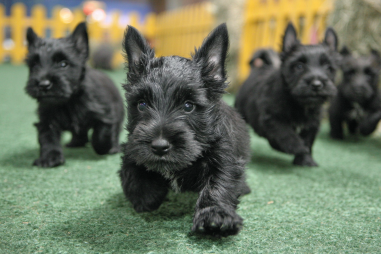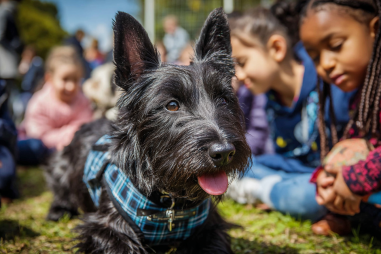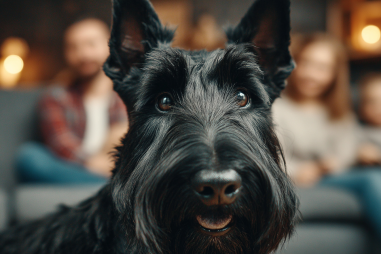Training a Scottish Terrier can be a rewarding yet challenging experience due to their independent and sometimes stubborn nature. Known for being fearless, intelligent, and quite the character, Scottish Terriers, or “Scotties,” require training methods that respect their unique temperament while encouraging good behavior. Understanding their traits and adopting effective training techniques tailored to their personality is key to raising a confident, well-behaved Scottie.
Positive Reinforcement Techniques
Scottish Terriers respond best to positive reinforcement methods. Unlike some breeds that may submit more readily to strict commands, Scotties are more inclined to cooperate when training is a fun and rewarding experience. Positive reinforcement involves rewarding your dog immediately after they perform a desired behavior with treats, praise, or toys. This approach helps your Scottie associate good behavior with positive outcomes.
Consistency is vital when using positive reinforcement. For instance, if you want your Scottie to sit on command, reward them with a treat and verbal praise the first time they obey. Repeat this practice regularly until the behavior becomes a habit. Avoid using punishment or harsh corrections as this can lead to mistrust or anxiety in your Scottie, making training even more difficult.
Crate Training Basics
Crate training is an essential foundation for Scottish Terrier training, aiding in housebreaking and creating a safe, comforting space for your dog. Start by introducing the crate as a positive environment rather than a punishment area. Place your Scottie’s favorite bedding and toys inside, and encourage them to enter by tossing treats in or sitting nearby while giving calm, reassuring commands.
Gradually increase the amount of time your Scottie spends inside the crate, always ensuring that the experience is pleasant. Never use the crate to isolate your Scottish Terrier for long periods, and avoid forcing them into the crate if they resist initially. Over time, a properly crate-trained Scottie will view their crate as a cozy retreat and be less prone to separation anxiety or destructive behavior.
Socialization Approaches for Confident Scotties
Early socialization is crucial for Scottish Terriers to develop into confident, well-rounded dogs. Their natural aloofness toward strangers and sometimes territorial behavior can lead to aggression or fearfulness if not addressed early. Start exposing your Scottie puppy to various environments, people, animals, and sounds shortly after their vaccinations.
Try group training classes or dog-friendly parks to provide controlled and positive exposure to other dogs. Use treats and praise to reward calm, friendly interactions. If your Scottie shows signs of fear or aggression, do not force interaction—instead, gradually reintroduce social situations with plenty of encouragement and patience.It’s also helpful to regularly invite guests over so your dog becomes accustomed to different people entering their territory.
Common Behavioral Challenges and Solutions
Due to their bold and independent nature, Scottish Terriers may exhibit certain behavioral challenges that require special attention during training:
- Stubbornness: Scotties are known for thinking independently, which can translate to stubbornness during training. Counter this by keeping training sessions short, engaging, and rewarding. Use high-value treats and toys to capture their attention.
- Barking: Scotties can be vocal watchdogs, barking at noises or strangers. Teach a reliable “quiet” command by calmly redirecting your dog’s attention when barking starts and rewarding silence immediately.
- Digging and Chewing: Their hunting instincts can lead to digging or destructive chewing. Provide plenty of mental stimulation and interactive toys to redirect these natural behaviors appropriately.
Addressing these challenges consistently and with positive methods will build trust and encourage better behavior.
Training Routines and Consistency
Scottish Terriers thrive on routine and consistency in their daily training. Since they can quickly become bored or distracted, having a clear, structured training schedule helps maintain their interest and reinforces learning. Aim for multiple short sessions throughout the day—typically 5 to 10 minutes each—to keep training fun rather than exhausting.
Be consistent with your commands, signals, and expectations across all family members. Mixed signals can confuse your Scottie and hinder progress. For example, if “sit” means sit in one session and is ignored in another, your dog won’t understand what you want. Using the same tone and words every time helps solidify commands and strengthens communication.
Using Treats and Toys Effectively
Motivation is a key part of successful training, and Scottish Terriers respond exceptionally well to tasty treats and engaging toys. Pay attention to what excites your Scottie most — some respond better to small, smelly treats like bits of cooked chicken or cheese, while others prefer a favorite squeaky toy as a reward.
Use treats immediately after a desired behavior to reinforce the connection between action and reward. However, be mindful not to overfeed, breaking treats into tiny pieces can help maintain diet balance. Incorporate toys as a reward through playtime to add variety to training, making learning more enjoyable and less repetitive.
Troubleshooting Stubborn Behavior
If your Scottish Terrier becomes stubborn or unresponsive, don’t get discouraged. This breed’s determination can sometimes manifest as resistance but understanding their mindset can help you overcome it. Here are some tips:
- Change the environment: If distractions are too high, move training to a quieter space until your Scottie regains focus.
- Increase reward value: Treat your dog with something exceptionally tasty or desired when they comply, to rekindle motivation.
- Take breaks: Sometimes a short break gives your dog time to reset their attention.
- Use a leash: For commands that require control, a leash helps guide and focus your Scottie.
Remember, patience is essential. Avoid raising your voice or showing frustration as this can create a negative association with training.
Patience and Persistence Make All the Difference
Training a Scottish Terrier requires a blend of patience, understanding, and persistence. Their unique personality means that a one-size-fits-all approach won’t work. Instead, tailor your methods to their individual needs and temperaments, always prioritizing positive reinforcement and consistency. With time and effort, your Scottie will learn to respond confidently, leading to a lifelong bond built on trust and respect.
By embracing their independent spirit while guiding them with kindness and firm routines, you’ll find that training your Scottish Terrier is not only achievable but truly enjoyable.







